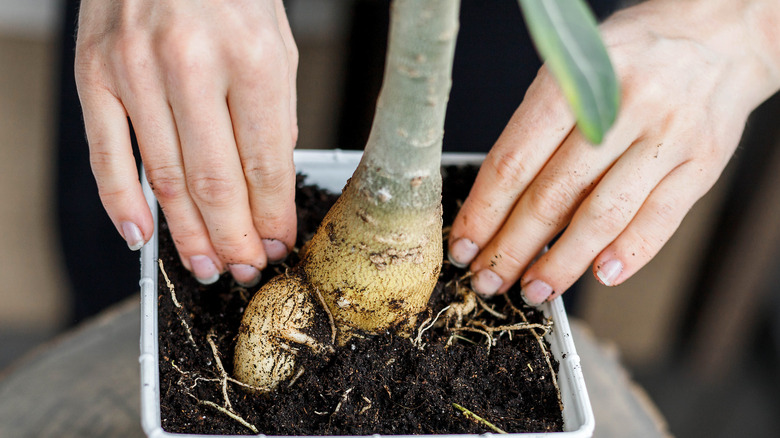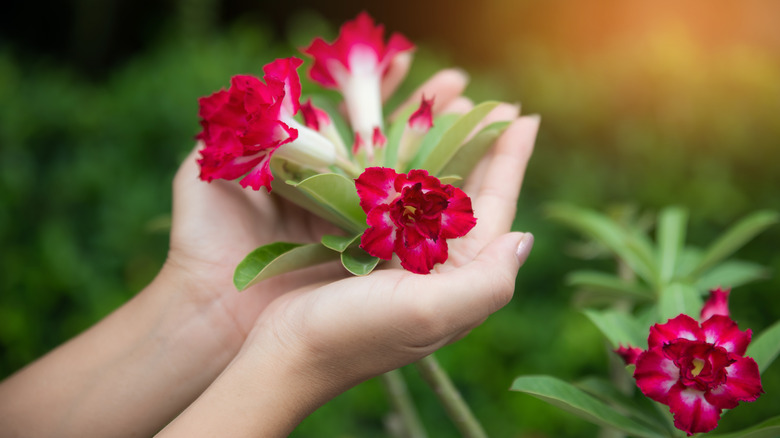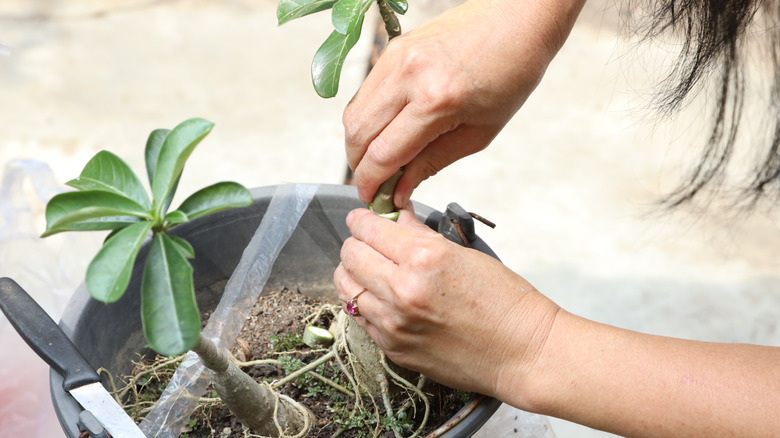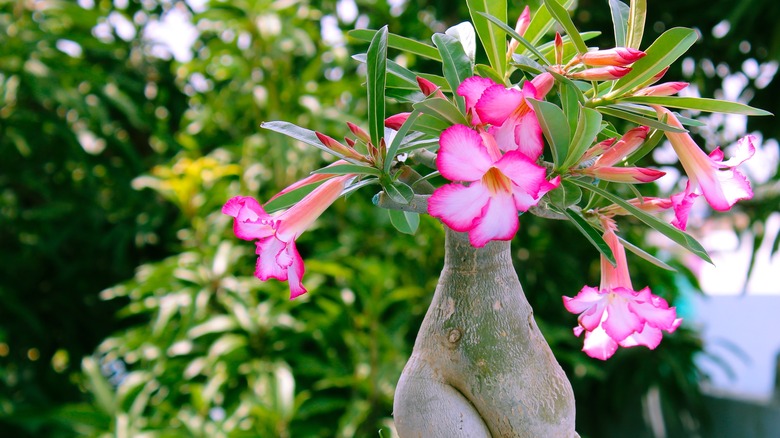How To Successfully Care For Your Desert Rose
A desert rose is a unique plant known by many names. Whether referred to as an impala lily, mock azalea, or otherwise, this plant is a popular addition inside and outside homes. They are identifiable by their swollen trunks, which give them a similar shape to the popular bonsai plant. However, they are also remarkable for their vibrant leaves that sharply contrast with white, pink, and red-mottled flowers.
This beautiful plant grows naturally in North Africa, South Africa, and the Middle East and thrives in warm and sunny climates. Keeping this in mind, you'll need to mimic these natural conditions to encourage your own desert rose to sprout and flourish inside or outside your own home. Since these plants are succulents, they require abundant sunlight, little watering, and careful nourishment. Learn more about the care and keeping of this distinctive succulent so you can cultivate your plant properly throughout its lifetime.
Understanding the desert rose's natural environment
The desert rose, or Adenium obesum, is a member of the Apocynaceae family and is native to the deserts found all over Africa and the Arabian peninsula. Due to the warm, tropical climate of its homeland, this plant is best grown in the United State Department of Agriculture (USDA) zones 10, 11, and 12. These are the warmest locations in the United States; Zone 10 has an average minimum winter temperature of about 30-40 degrees Fahrenheit, while Zone 12 averages around 50-60 degrees Fahrenheit.
According to the "Plant Hardiness Zone Map", these zones are limited to the far western and southern contiguous United States and Hawaii. If you live outside of these habitable zones, it's highly recommended that you grow your desert rose indoors to provide it with proper living conditions. In fact, you should even be wary when planting in Zone 10, as temperatures can drop to dangerously low levels that aren't sustainable for the Adenium obesum's survival unless you take extraneous measures.
Choosing a spot for a desert rose
If you live in a habitable zone for the desert rose, the next step is determining where in your yard to plant it. Remember, as their namesake indicates, they are desert plants and should be planted in a location that mimics that biome's conditions. These succulents thrive under full sun exposure, so be sure to plant them in a location that won't be shaded by taller trees or bushes. If they aren't placed where they can receive adequate sun, you will know, for their flowers will never bloom.
You should also consider their proximity to other plants and features on your property before committing to a spot. Each plant should be at least two feet from other plants so it has room to spread its stems, flowers, and roots. This plant does best with more space to itself, so the further away you can place it, the better. Try to keep your desert rose at least two feet away from your driveway, sidewalk, or stone or concrete path. When the flowers fall at the end of a season, the vibrant petals can stain other features on your property. Keeping your succulent at a safe distance from any concrete or stone will keep fallen blossoms on your lawn rather than your pathways.
You should know that many people grow these succulents in oversized pots in their yards and homes. Putting it in a pot allows you to take it with you if you move or change your landscape without uprooting your plant. Start with a container at least 12 inches wide and six inches deep, but expect to double its size yearly until your plant reaches full maturity. If you're placing it in your home, make sure it's near a window that receives bright light throughout the day. If none of your rooms have sufficient natural light, you can always invest in grow lights to aid in its survival.
Planting a desert rose
Planting tips and instructions vary depending on if you're planting a seed or a rooted plant. As a general rule, the best time to plant this species is during the spring, when temperatures are on the rise and there are no cold snaps on the horizon. You should grow it in neutral to slightly acidic soil with a pH of about 6.0, which is the composition of most succulent soil mixes. This soil should also primarily be composed of peat, bark, or sand, enabling it to dry and drain easily. You can improve drainage by adding perlite, which is a very light substance that retains moisture, making it ideal for desert greenery.
Like most plants, the desert rose thrives in well-draining soil — too much water can be fatal. Expect a seedling to grow slowly, for it can take up to three years to reach full maturity. However, seeds are likely to sprout flowers faster than a cutting. Cuttings take longer to adjust to their new environment and can take years to bloom.
Nurturing a desert rose
Above all else, an Adenium obesum should be kept in a desert-like environment, and temperatures of at least 50 degrees and higher are recommended to keep this flower alive throughout the winter. If your plant is in a pot, you can move it indoors or against a wall to help it retain heat. You can also force dormancy by cutting off the leaves or allowing your plant to drop leaves naturally. If your plant is permanently situated outdoors and the temperatures fall too low, cover them in two layers of plastic sheeting.
In addition to maintaining their environment, you should follow proper fertilization and watering practices. Fertilize a newly sprouted plant throughout the growing seasons, spring and summer, with a 20-20-20 fertilizer. Once your Adenium obesum is old enough to bloom and its flowers appear, switch to a high-phosphate flowering fertilizer, such as a 5-50-17. You should not water it too often, and the exact routine depends on your local climate, soil mix, and how much light the plant is getting. Outdoor plants may need watering one or two times a week, but indoor plants require even less and you can usually water them bi-weekly. Professional gardeners recommend misting indoor desert roses to ensure you don't accidentally waterlog the soil.
Knowing the types of desert roses
According to recorded history, Adenium succulents were first cultivated in 1883, and many other varieties have been created and nurtured over time. Although Adenium obesum is the most common desert rose plant, with its deep red, pink, or white leaves, other plants within the Adenium genus can also beautify your home. The Adenium arabicum is distinguishable by its thick trunk and wide stems that point upwards with floral growth on the top. This species of Adenium blooms pink flowers. There is also the Adenium multiflorum, which sports many flowers in reds and pinks, though it tends to bloom later in the year than other members in its genus.
If you're looking for a variety that doesn't grow very large, you should consider Adenium crispum. This species usually doesn't stand above two feet and produces flowers with unique stripes across their petals. In general, you should choose a variety that you find both pretty and suitable for your environment. Through cultivation and cross-breeding, botanists have grown unique Adeniums with alternating tolerances, color schemes, and shapes, ensuring you'll find one that befits your aesthetic.
Understanding the toxicity of desert rose
The toxicity of the desert rose is unquestionably strong, and it is extremely poisonous for both animals and humans. This plant contains a cardiac glycoside toxin, digitalis, which directly interacts with the heart muscle (via Wag Walking). Consuming or touching the plant sap causes poisonous effects in 12-36 hours, and the most commonly reported health effects in people are dizziness, malaise, nausea, and vomiting (via Tips Plants). Consuming large amounts of this plant and its sap can even be lethal.
If you have pets, you'll want to ensure they do not have access to this plant since eating it or even licking it can cause severe health issues. Keep your plant sanctioned in a fenced-off garden or a closed room to keep your pets safe, especially if they are curious eaters. This advice is also applicable if you have young children with adventurous appetites.
Propagating a desert rose
Propagation is a popular practice among casual and professional gardeners alike. It is the process of taking a portion (cutting) from a mature plant and growing a new one from that piece. Propagating a desert rose has a high success rate, and many people even graft two cuttings together to create new hybrid species.
To properly grow your Adenium succulent from a cutting, you must first allow a cut-off piece to dry out for a day. It's recommended that you dip the bottom end in a rooting hormone, which is a chemical used to encourage root growth and improve your chances of creating a new plant. After applying the rooting hormone, place it in well-draining soil mixed with sand or perlite. You should mist it daily for up to six weeks, and by this time, the cutting should have taken root, making your propagation a success.
Preventing desert rose pest infestations
Whether indoors or outdoors, your desert rose plant is susceptible to pests and diseases like all other living things. There are four primary garden pests to watch for; aphids, mealybugs, scale, and spider mites. These creatures infest the leaves of plants, feasting on sap until a plant slowly withers and dies. You can deter these creatures by coating your desert rose in neem oil, a natural pesticide and fungicide that prevents future and current infestations by repelling bugs at every stage in their life cycle. It's recommended that you only apply this oil in the evening so it has time to set in before the next day's light. Neem oil's properties make leaves more vulnerable to sun scorching, and you'll want to avoid this issue while trying to fight off an infestation issue.
If you live in a coastal area in the southeastern United States, you should also watch for oleander caterpillars. These caterpillars thrive by feeding and laying their eggs on plants like desert roses. Their infestations aren't fatal; however, they will strip your plant bare and leave it exposed to the previously discussed pests.
Treating desert rose diseases
In addition to bug problems, you should also watch for diseases. The fungi Anthracnose causes discolored lesions on plant leaves and forms tiny bumps on the undersides. Although anthracnose won't outright kill your plant, it will leave it vulnerable to other infections and pests. Treat the issue by pruning affected areas and disposing of the pieces. Don't let the clipped stems litter your yard, for the fungus will continue to spread and infect other plants on your property. If the disease returns after treatment, you may need to take more drastic measures, like changing the soil or applying fungicide. If you're looking for a more natural treatment, consider using neem cake fertilizer which kills soil-based Anthracnose spores.
Desert roses are also susceptible to root rot from overwatering. This is another fungus infection and is often caused by excess moisture in the soil. You'll recognize the symptoms as spotting on your succulent's stems or trunk. This is also treatable in the same way you would treat an anthracnose infection. As a side note, if you're having issues with root rot, you should probably ease up on your watering routine.
Blooming expectations with a desert rose
When kept healthy in a prime environment, most species of desert rose can reach between three to nine feet tall and three to five feet wide. They grow very slowly compared to other plants, which is why they often don't reach full maturity until age three. As they grow older, the trunk will divide, giving it a more bonsai-like appearance.
Depending on where you live and the species of Adenium grown, you can expect flowers from late spring to early fall. These flowers reportedly last a week or multiple weeks, again depending on your local climate and type of plant. If you're struggling to get your plants to bloom, make sure you're using a fertilizer rich in phosphorous. The second number on the fertilizer label indicates how much phosphorous is in the mix, and a higher number will help provide the nutrients your plant needs to flower.
Decorating with a desert rose
With all your knowledge of successfully caring for a desert rose, you should also know how to place it inside or outside in an aesthetically-pleasing way. Your main priority should be placing your plant in a location where it can get adequate sunlight and heat. However, this doesn't mean you must forgo interior design and landscaping recommendations. Desert roses make great additions to eclectic garden areas, and they thrive with other plants that prefer similar conditions. "Tokyo Sun" stonecrops, artichoke agave, and mezoo doreanthus are other succulent plants that match the desert vibe of Adenium obesum. These species have thick cactus-like leaves that will add more greenery to your garden and complement the thick trunk of a desert rose.
Decorating with a desert rose indoors is easy. Due to the uniquely ornamental shape of this plant, it can be placed as a standalone decorative element in your home. You can choose a clay, metal, ceramic, or other unique pot that matches the rest of your interior decor. The material of the pot doesn't matter as long as it has drainage and is large enough for your plant to thrive.











